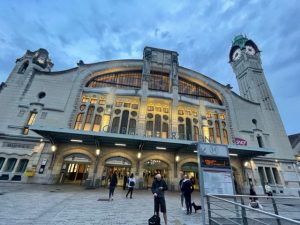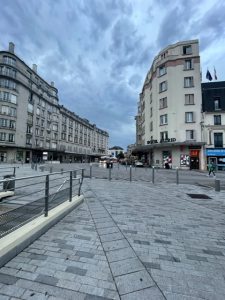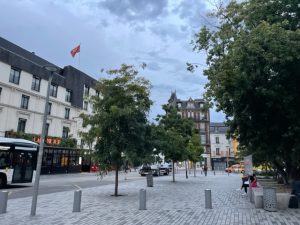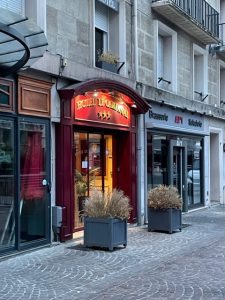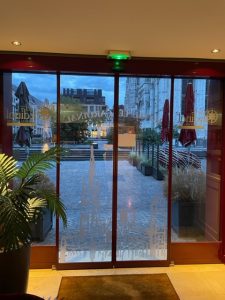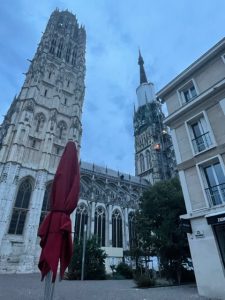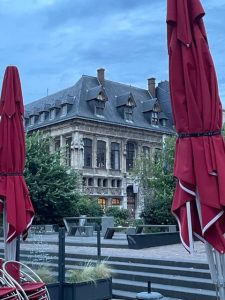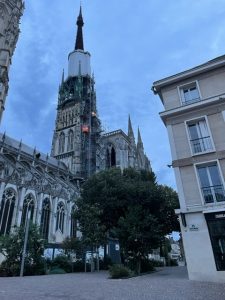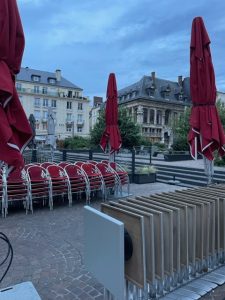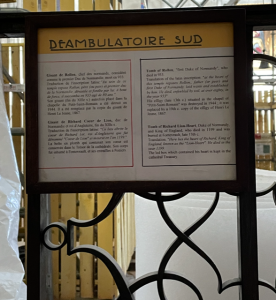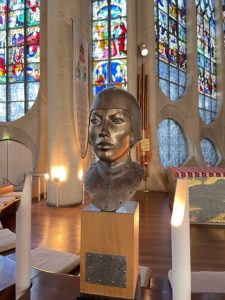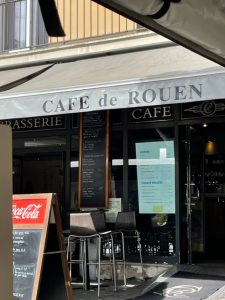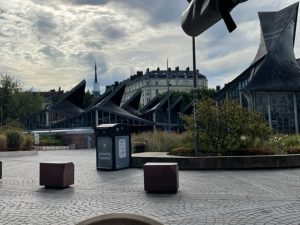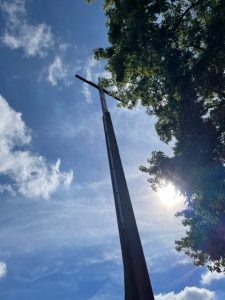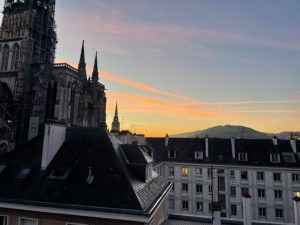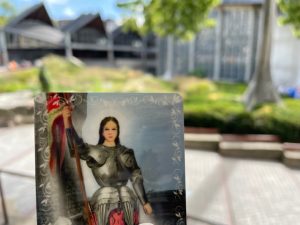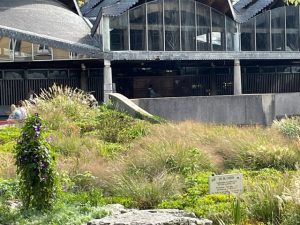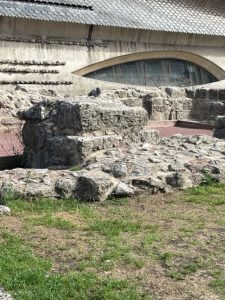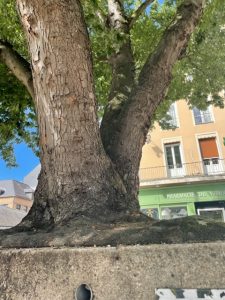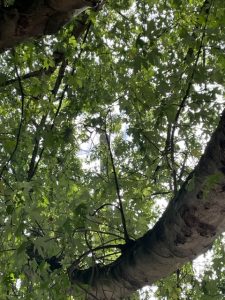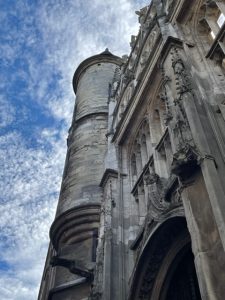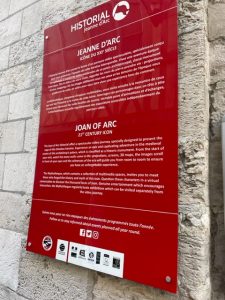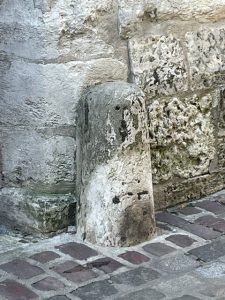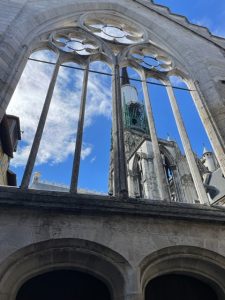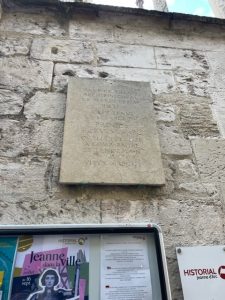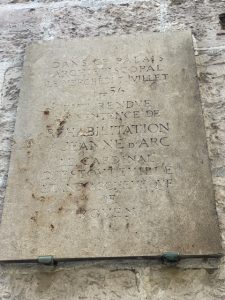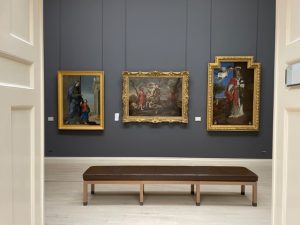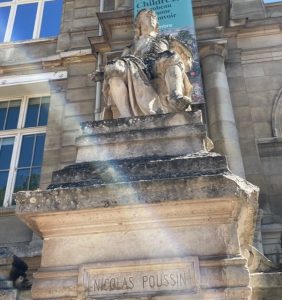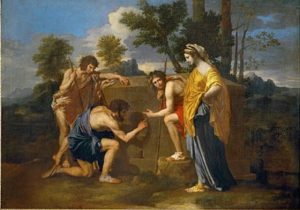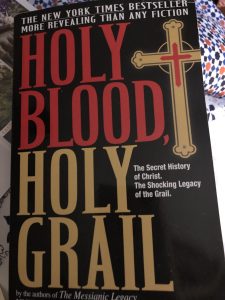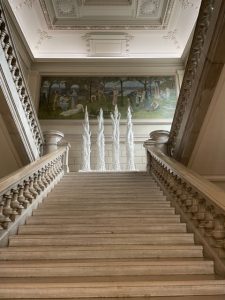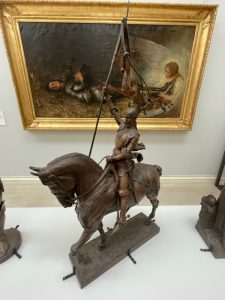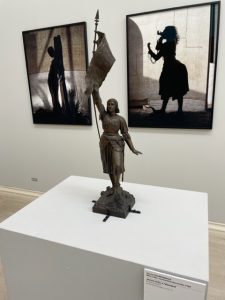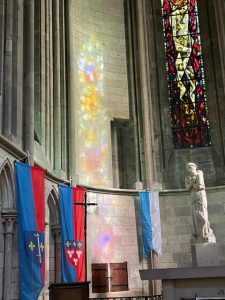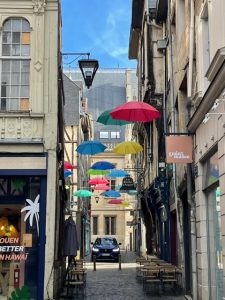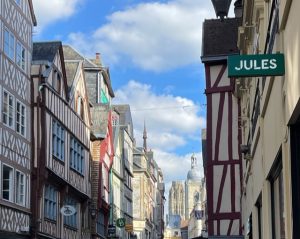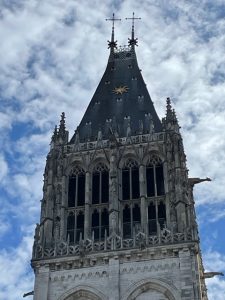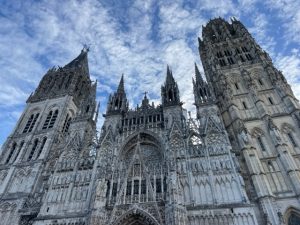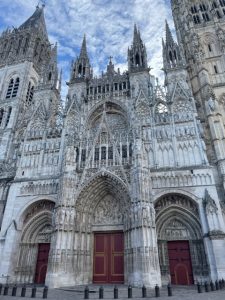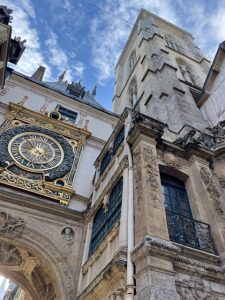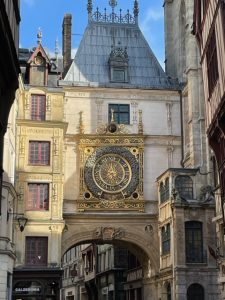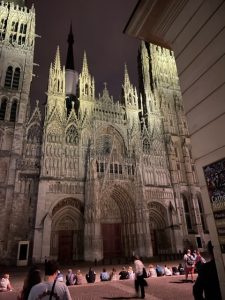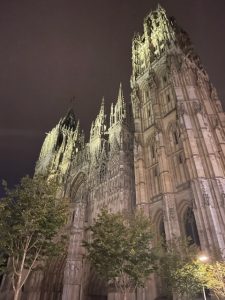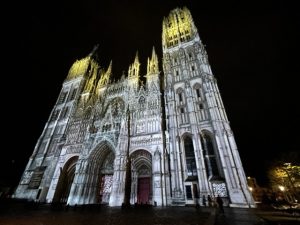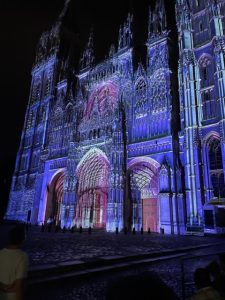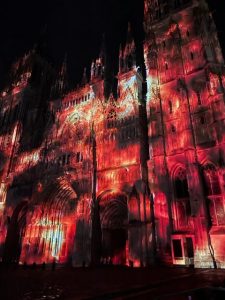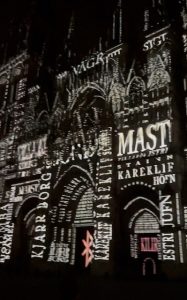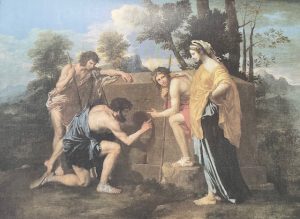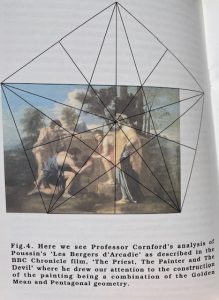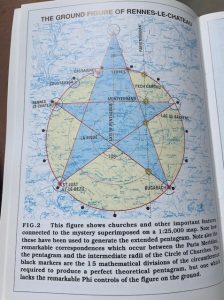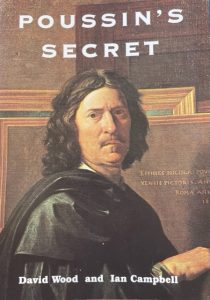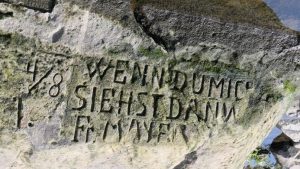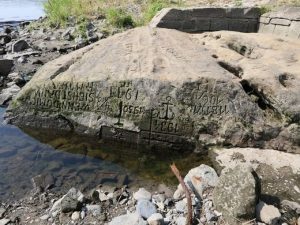Poussin
Dayle in Limoux – Day # 70
September 14, 2022Travel day full of trains and bus back two Limoux from Rouen.
First leg a little over five hours, to Marseilles. Much easier this time, maneuvering platforms and screens in the Marseilles terminal. Then, a three hour plus train ride to Carcassonne. It’s so interesting to me how I only have to say, “Bonjour,” and the first typical response is, ‘Oh, English.’ Almost feel like I should apologize. How do they know? Yes, I think it’s because my French pronunciation is really quite that bad. Not giving up. I so want to speak this beautiful language. I try. In the Rouen museum, I think I was pronouncing the painter Poussin, as ‘poisson,’ which is ‘fish’ in French. So the musée attendant was seemingly perplexed when I asked for directions to the Poussin exhibit and thought I said, “Where is the fish exhibit?” We finally figured it out together, both were laughing.
Leaving Hotel Cardinal early in the morning, the quiet of the cathedral square, the majesty of The Rouen Cathedral.
The cathedral a religious monument constructed in two phases with two distinct styles: starting in 1030 for its Roman-inspired section and in 1145 for its Gothic-inspired one. It was completed in 1506. It houses the remains of King Richard the Lionheart lie in the Cathedral.
I was asked if I was English (I guess so?) on the second train by a young man sitting next to me. He is from Ft. Collins, Colorado–my son’s age. One of my most favorite things traveling is meeting someone and talking with them as if we’ve known one another for a long while. His name is Hopper and we talked about everything from absolute truth, to ashrams in India, to the transgender movement–for three solid hours until the train stopped in Carcassonne. He wants to leave the United States, too. He’s going to work on a farm in France for a while, and then move to the Czech Republic, before finally landing in India. It was a lovely conversation. I haven’t spoken that much English in a long while.
I met with two women this morning, one who had been living in Portugal, now in Limoux and originally from Boston. The other women I had met earlier after I arrived. Learning so much about life in Limoux, their experiences, and future plans. La crème à café on the Place de la Republique. The best. l o v e
À bientôt.
🚉
Dayle in Limoux – Day # 69
September 12, 2022
Place du Vieux-Marche’, Old Market Square, where Joan of Arc was burned at the stake. Apparently, Joan’s body was burned three different times, and her burning was prolonged by the sadistic executioners to lengthen her pain and torture.
From The Guardian:
‘What is generally agreed is that Joan’s body was burnt three times by the English and ashes from the foot of the pyre were supposedly discovered in 1867, lurking in the Paris loft of an apothecary .
French scientists, who have been studying those ashes, confirmed (in 2006) that a piece of cloth found among the remains may have been a fragment of Joan of Arc’s gown. A new series of DNA tests of bones and tissue found among the ashes is expected to confirm that they belong to a female.
The most exciting discovery by his 18-strong team at the Hôpital Raymond Poincare near Paris was in the carbon-dating of the piece of cloth. ‘It is linen of high quality and we can confirm that it dates from the 15th century. It could have been a robe or a bag.’
According to historians, Joan of Arc was 19 when she was burnt at the stake in Rouen by the English on 30 May, 1431. She died of smoke inhalation. The Cardinal of Winchester is recorded as having ordered her to be burnt a second time. Her organs still survived this fire, so a third burning was ordered to destroy the body completely. Her cinders and debris were to be thrown into the Seine.
However, in 1867 ashes that were said to include remains of Joan of Arc were found in the Paris loft of an apothecary. These were transferred to a museum in Chinon where they are still kept.
I spent the entire morning at this sacred spot in the Old Market Square. I started at the Rouen Cafe, and then settled closer to where she was burned.
A massive crucifix is placed in the exact spot where Joan was burned alive. Reportedly, Joan asked to be able to see the cross as she was being executed. The last word she screamed was, “JESUS!”
(The bells of the cathedral are ringing now. Sometimes, not knowing the reason, they just ring and ring in these magnificent harmonies. So incredibly beautiful. Those deep, melodic, bellowing tones. Many bells surround the square. Inspiring. And to wake up with them in the morning, ethereal. This is first light today from my window…
Back to Joan. :)
This is the base of the giant crucifix, with the Joan of Arc church and her statue just behind.
And these are ancient stones from Joan of Arc’s time that were left in place at the Old Market Square.
Here’s the tree where I sat under for prayers and meditations this morning…I could see the crucifix through the branches.
So peaceful. Tranquil. It’s Monday, and after the many tourists left from the weekend, the locals were out and about on their bikes; on Mondays, many establishments are closed, I learned brokenheartedly. Still, able to see and explore so much.
When I finally pulled myself away from the Old Market Square, I trekked to find a historical monument where Johanne was tried and convicted, imprisoned, after being betrayed by her country and king, Charles the VII. Supposedly there’s this interactive virtual thing we can take part in, not typically my thing, yet, rave reviews. I found it! Sadly, one of the establishments that are closed on Mondays. Next time. I was able to linger awhile and take in the historic splendor, knowing Joan was there, her energy, her eloquence, your loyalty, and her truth. History shows her arguments were pure in logic, and forthright, often beleaguering the m e n trying to convict her. Their minds were made up, if not, she would have walked free.
Look at these ancient standing stones! Made up for the fact the historical establishment was closed. :) They are placed on each side of the door.
This is the courtyard right next to the historical site. Legal hearings? Council? Not sure.
And these are the two ancient plaques, explaining what transpired with Joan. After her execution, it is here Charles VII said, whoops, our bad. She was declared innocent. Sorry about the burning thing. And in 1920, of course centuries later, not unlike Mary Magdalene, her virtues and faith and historical contribution were recognized, and she was canonized as a saint.
From here, knocked out to learn that at the art museum in Rouen, there are three original paintings by Nicolas Poussin!
Poussin was actually from Normandy, and Rouen is the capitol of Normandy. There’s a statue of him outside the museum…
If you’re following the Dayle in Limoux posts, you know he painted ‘Et in Arcadia Ego’ which is based on the sacred geometry in Languedoc and Renne-les-Chateau…the Cathars.
This is a capture from 2019, visiting the site of the ‘tomb,’ no longer there because the owner of the property was tired of the visitors. He destroyed it. Tragically. This photo was taken in Languedoc, aligning with the sacred geometry.
Everything Sir Henry Lincoln wrote about with his co-authors in the book that started the intrigue all over again.
Here’s a couple of YouTube reviews.
Pousinn’s French Baroque style was also considered French Classical tradition. He was a major inspiration for such classically oriented artists as Jacques-Louis David, Jean-Auguste-Dominique Ingres, and Paul Cézanne.
This later version of Et in Arcadia Ego has a far more (sacred!) geometric composition, and the figures are much more contemplative. The mask-like face of the shepherdess echos the Classical “Greek profile”. And! It’s in the Louvre. Someday, when I get back to Paris. Can’t wait. If I lived in Paris, I would go the Louvre every weekend. I would!
From thegoodlifefrance.com:
Joan of Arc claimed to have communicated spiritually with saints at a rural location some two kilometres from her home. She identified them as Michael the Archangel, St. Catherine of Alexandria and St. Margaret of Antioch. The last two saints were virgin martyrs who had refused to take orders from men and, when leading the French army into battle, Joan dressed as a man to avoid prejudice. The spot is well marked. An extremely grand and prominent Basilica was built at the location as late as 1881. Masses are held there every Sunday and great mural artworks portraying her military capacity surround the walls. In the grounds around it, visitors will find impressive sculptures and statues of Joan, the saints that communicated with her and her pious father Jacques, who shaped her childhood. The Basilica is impressive, features a vast spire and can be seen from miles around amongst the local countryside.
Joan of Arc was captured in the city of Compiegne, Picardy at the start of May, 1430. She was held by the conspiring Burgundians who sold her to the English for 10,000 Francs.
Her trial took place in Rouen, the capital city of Normandy. She was convicted of witchcraft and heresy by the English and Burgundian authorities and sentenced to death by burning at the stake in the centre of Rouen on May 30th, 1431. The English executioners apparently went to much trouble to ensure that her death was as slow and distressing as possible. She was just nineteen years old. Twenty years later, a retrial took place in the same courtroom and found her innocent of all charges.
Her exact place of execution is marked by a vast concrete cross. Right next door rests a contemporary church to commemorate her. Digital son et lumiere dramatically presents features of Joan’s life on the face of the city’s Notre Dame Cathedral. The vast Excel walk round cinema on the banks of the Seine River flowing through Rouen, features a similar, stunning feature. The courtroom where she was tried twice, houses an ultra-modern, active digital museum that almost brings her back to life.
Joan of Arc was canonised in 1920 and is the patron saint of France. More than 20,000 books have been written about her. Her persuasion, untaught military skills and undoubted faith in her religious beliefs were extraordinary achievements by one who lived such a short life.
I was able to research and study the Poussin paintings for awhile with the complimentary WiFi in the museum; beautiful structure.
They have a hall dedicated to ‘Heroines,’ too. Many sculpture’s and paintings of Johanne. I’d like to have one of these, please.
And then, from here it was back to the Cathedral to sit in front of Joan of Arc’s chapel. I lit two candles, one each for my two children, William Henry, and Annie Glenn, to keep Joan’s fierce protection surrounding them, and her compassion guiding them.
Look at the light from the stained glass panel.
s
p
i
r
i
t
Some photos from today…captures…and the Cathedral…Rouen is beautiful, ancient medieval architecture with splashes of contemporary color.
Here comes the sun…see it right at the top? 🌞
The clock! From the 1300’s. It still rings at 9:00 at night to signify what was once, ‘curfew.’
And, at night. Tres jolie.
And then, preparation for the light and music show with the cathedral as the giant canvas…on the tallest cathedral in France…✧ * . * ✧ . * . *
. * . * . for the magic. . ✧ .
✧ ✧ * . * . . *. .
✧ * . . ✧ . * . *
This is the Rouen Cathedral of Notre Dame. This year the light and music show runs June 3rd to September 17th. It’s spectacular. Folks say it’s a ‘must-see summer event.’ No doubt. It shares the story of Joan of Arc and the Viking history.
Here’s about 13 minutes someone posted on youtube from this summer. The presentation is about 50 minutes in total. I wish everyone could see it. Incredibly inspirational. We need lots of inspiration on our planet right now. Tell the stories, share the history. Feel what is possible. Thanks be to those who create these beautiful messages when we need them most. Love watching the younger spirits, enthralled, wondering how they will be inspired, what they too will create, sowing those tiny seeds of promise and possibility.
b
e
l
i
e
v
e
https://youtu.be/JFq26L0m5ek
J’adore Rouen. Find the light.
Bonne nuit!
Dayle in Limoux – Day #41
August 15, 2022
One of my favorite writers, Rebecca Solnit, posted this on social media–a quote from Robin Wall Kimmerer, a cherished essay called, Braiding Sweetgrass: Indigenous Wisdom, Scientific Knowledge, and the Teachings of Plants.
More from Robin…
‘Grieving is a sign of spiritual health. But it is not enough to weep for our lost landscapes; we have to put our hands in the earth to make ourselves whole again.’
‘Action on behalf of life transforms. Because the relationship between self and the world is reciprocal, it is not a question of first getting enlightened or saved and then acting. As we work to heal the earth, the earth heals us.’
🌹There is no death. There are only new beginnings. As the sun sets it rises somewhere else. Whether it’s dawn or dusk, the light is always burning, always evolving into greater love.
-Jennifer Rose
‘We are called to be architects of the future, not its victims.’
-Buckminister Fuller
Reading this quote again earlier today, my mind wallowed to Poussin’s own discovery of the Sacred Architecture in the Languedoc/Occitanie region of France and his painting, Les Bergers d’Arcadie (The Shepherds of Arcadia). Some consider it to be one of the greatest mysteries in France.
Et in Arcadia Ego
‘Even in Arcadia, there am I’
[Images are from the book, ‘Poussin’s Secret.‘]
“Seeing this complex harmony of trigonometrical, geometrical and doctrinal factor so brilliants interlaced, forcibly reminds one of the face that even Louis XIV went to considerable lengths to pursue this mystery. He knew that the Poussin painting held clues to a great secret, and he eventually became its owner.
His interest was no doubt precipitated by a strange letter which his Superintendent of Finances, Nicolas Fouquet, received from his brother, the Abbe Louis Fouquet, after the latter had met with Poussin in Rome. Part of the letter reads:
‘He and I discussed certain things, which I shall with ease be able to explain to you in detail. Things which will give you, through Monsieur Poussin, advantages which even kings would have great pains to draw form him and which, according to him, it is possible that nobody else will ever rediscover in the centuries to come. And what is more, these are things so difficult to discover that nothing now on this earth can prove of better fortune nor be their equal’ [p.23].
❦
Marianne Williamson:
‘According to ancient Asian philosophy, life is not a straight line but a spiral.’ (A go-to doodle!)
‘Every life lesson that has ever been presented to me (which means everything I have ever been through) will come back again, in some form, until I learn it. And the stakes each time will be higher. Whatever I’ve learned will bear greater fruit. Whatever I’ve failed to learn will bear harsher consequences.
Whatever didn’t work in my life before this point was a reflection of my failure to integrate the different parts of myself. Where I didn’t yet accept myself, I attracted a lack of acceptance in others. Where I hadn’t yet dealt with my shadows, I manifest shadowy situations. Broken parts of me encountered broken parts of others. But now I know! That was then and this is now.
The situation is what it is, although we will invariably cycle through stages of denial, anger, bargaining, resignation, and (hopefully) acceptance. The suffering might feel wrong, terminal, absurd, unjust, impossible, physically painful, or merely beyond our comfort zone. Can you see why we must have a proper attitude toward suffering? So many things, every day, leave us out of control—even if it is just a long stoplight. Remember, however, that if we do not transform our pain, we will surely transmit it to those around us and even to the next generation.’
Here endeth the lesson. :)
18 degrees cooler than the average over the last two months, which is actually, or was, the normal temperature this time of year. Read this earlier from AXIOS:
A new study reveals the emergence of an Extreme Heat Belt from Texas to Illinois, where the heat index could reach 125°F at least one day a year by 2053.
- That sweltering region includes St. Louis, Kansas City, Memphis, Tulsa and Chicago.
- By 2030, some coastal areas in the Southeast and Mid-Atlantic may also experience days with a heat index above 125°F, the report found.
The findings come from a hyperlocal analysis of current and future extreme heat events published today by the nonprofit First Street Foundation.
And from director and co-writer of the film, “Don’t Look Up”, Adam McKay posted this earlier on social media:
“This is full on as terrifying as anything I’ve ever seen.”
The recent droughts in Europe once again made visible the “Hunger Stones” in some Czech and German rivers. These stones were used to mark desperately low river levels that would forecast famines. This one, in the Elbe river, is from 1616 and reads: “If you see me, cry.”
[Shoko Asahara Appreciation Consortium]
‘Even a wounded world holds us…’
À bientôt.
❀
